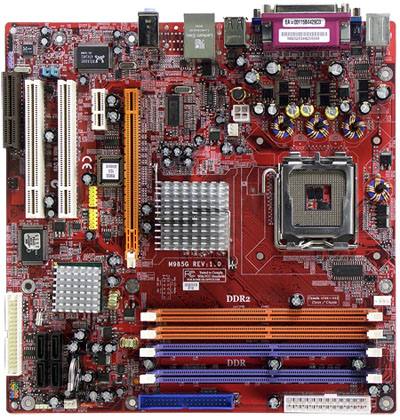 |
||
|
||
| ||
Almost a year has passed since we reviewed the last motherboard on Intel 915P/G. But it does not mean that motherboards on a chipset from this series are outdated. On the contrary, it's a good choice, if you are pressed for money, because such motherboards are cheaper than top models on i925X/XE-945P/G/955X chipsets, but they still support PCIE and DDR2, which makes upgrading to the new standards a tad cheaper. Today we are going to review one of such budget solutions. You shouldn't expect anything extraordinary from the model under review. It's just a budget solution - with its functionality limited to minimum. In fact, it can only boast of a network controller, based on the Realtek RTL8100C chip, and an audio controller, based on AC'97 codec Realtek (Avance Logic) ALC655. Everything is quite standard. But the main advantage of this motherboard is its support for two memory types and a low price. It's all crystal clear about the latter, as PCChips specializes in inexpensive models. Thus, the price for this model cannot be high. What concerns the support for two memory types, it remains a topical issue, as the transitional period from DDR to DDR2 is at full swing and not all users want to spend their budget on memory, having paid for an Intel Socket 775 processor and a PCIE video card.  We can say nothing bad about the layout. It's a microATX motherboard - there is nothing surprising about it, considering its functions. It should be mentioned that all (just a few) ports and connectors are conveniently arranged on the board. We had no problems assembling the system. Access to the jumpers is not hampered, when the motherboard is installed into a PC case. Their brief descriptions are provided on the PCB. The 4-phase switching voltage regulator of the processor incorporates eight 1800 uF capacitors and three 820 uF ones. The board also contains a voltage regulator for memory (twelve 1000 uF capacitors reinforced with L-elements). In general, critical circuits incorporate electrolytic capacitors from Ost. PCB dimensions - 245x245 mm (standard microATX, the board is firmly mounted with eight screws). System monitoring (Winbond W83627THF, according to BIOS Setup)
Onboard ports, sockets, and connectors
Back panel (left to right, blockwise) Click the image to open the rear view of this motherboard
Package Contents
Integrated Controllers
The integrated audio quality was tested in 16bit, 44 kHz using the
RightMark Audio Analyzer 5.5
test application and the Terratec
DMX 6fire sound card:
General performance: Good. Settings
We used BIOS v.0120, the latest available BIOS version at the time of our tests. The mentioned BIOS parameters are available in this version, but the viability of non-standard settings hasn't been tested.
Performance
Unfortunately, we haven't tested motherboards of this design for a long time already (Intel 915G + DDR/DDR2), so we practically cannot compare these results with other models. But not long ago we tested the RS400-A motherboard from ECS, which also supported two memory types. It was equipped with a chipset from ATI though. The table below contains the results of these two motherboards, demonstrated with various memory types.
Of course, it's not correct to compare motherboards on different chipsets, but as both models are in the same price segment, support two memory types, and serve the same cause (to be the cheapest transitional stage between the old and the new standards), it will be interesting to see which model is faster. What concerns the prices, both motherboards come at less than 100$. But PCChips M985G leaves its competitors far behind in performance, so ECS RS400-A will hardly be successful. Conclusion:PCChips M985G demonstrated very good results for a motherboard of this price segment. If we also take into account its price and support for two memory types, this motherboard under review is definitely a good bargain in the <100$ price segment.
This model on the manufacturer's web site The motherboard is kindly provided by the manufacturer
Write a comment below. No registration needed!
|
Platform · Video · Multimedia · Mobile · Other || About us & Privacy policy · Twitter · Facebook Copyright © Byrds Research & Publishing, Ltd., 1997–2011. All rights reserved. | |||||||||||||||||||||||||||||||||||||||||||||||||||||||||||||||||||||||||||||||||||||||||||||||||||||||||||||||||||||||||||||||||||||||||